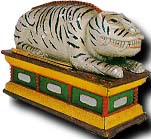
Philosophical Foundations of Korean Music (Continued)
In comparison with Western-style music, which generally employs the heptatonic scale, Korean music typically uses the continental pentatonic scale of kung, sang, kak, chi, and U, comparable to the Western do, re, mi, sol, la. The philosophical foundation, particularly of Korean court music, is rooted in teachings from the ancient Book of Ceremony, one of the most important sources of Confucian scholarship. What sort of energy is music?
BOOK OF CEREMONY CHAPTER "RECORD OF MUSIC"Musical performance is the acoustic output of the mind onto the voice, body, or instruments crafted from eight of nature's materials such as wood, bamboo, silk, clay, metal, leather, stone, or gourd. Reflection of the movements of the mind, music may be so overwhelming that it needs moderation with proper ceremonies, as benevolence with righteousness, heaven with earth, expansion with retraction, motion and repose.
The Confucian ruling class seems to have reasoned that the power of music could either enforce or corrupt the social order. Therefore, "correct music" had to be administered, and it is not coincidental Korean court music has come to be called chôngak, "correct music," an exemplary embodiment of the five elements.

Chuk

Eo
The ceremonial court orchestral performance typically utilizes two instruments for opening and closing: the chuk is a wooden percussive instrument that looks like a milling mortar painted green and placed to the east where the sun rises and all things begin, and played only in the beginning by tapping three times to announce the start with a pestle-like object. The eo is also wooden, shaped like a crouching haet´ae (a mythical tiger-like animal), painted white and placed to the west where all things end, and played only to end the music by scraping its toothed back three times with a kyônch´ae, a bamboo stick split into nine strips.





Korean traditional music can be divided into Korean folk music, aristocratic chamber music, Korean court music, and religious music.







